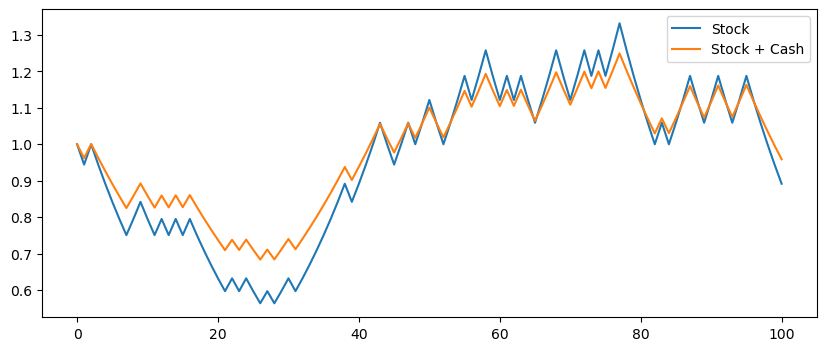Log-Optimal Portfolios
Contents
Log-Optimal Portfolios#
This notebook demonstrates the Kelly criterion and other phenomena associated with log-optimal growth.
Initializations#
import matplotlib.pyplot as plt
import numpy as np
import random
Kelly’s Criterion#
In a nutshell, Kelly’s criterion is to choose strategies that maximize expected log return.
where \(R\) is total return. As we learned, Kelly’s criterion has properties useful in the context of long-term investments.
Example 1. Maximizing Return for a Game with Arbitrary Odds#
Consider a game with two outcomes. For each \\(1 wagered, a successful outcome with probability \)p\( returns \)b+1\( dollars. An unsuccessful outcome returns nothing. What fraction \)w$ of our portfolio should we wager on each turn of the game?
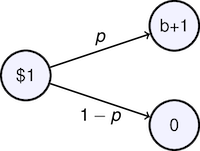
There are two outcomes with returns
The expected log return becomes
p = 0.5075
b = 1
w = np.linspace(0.0001, 0.1, 1000)
plt.plot(w, p*np.log(1 + w*b) + (1 - p)*np.log(1 - w))
plt.xlabel("wager fraction")
plt.ylabel("E[ln R]")
plt.title("Expected log return versus wager")
Text(0.5, 1.0, 'Expected log return versus wager')
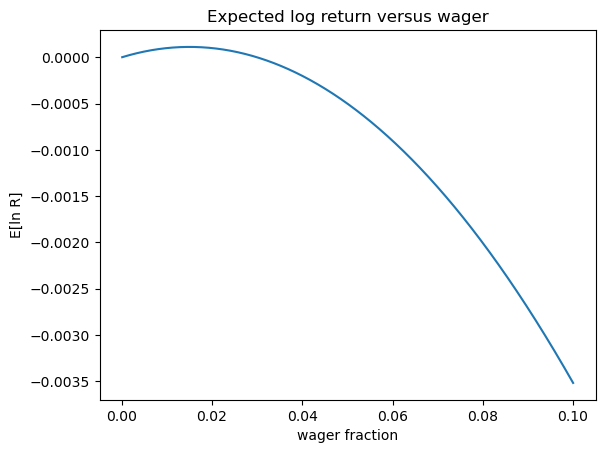
Applying Kelly’s criterion, we seek a value for \(w\) that maximizes \(E[\ln R]\). Taking derivatives
Solving for \(w\)
The growth rate is then the value of \(E[\ln R]\) when \(w = w_{opt}\), i.e.,
You can test how well this works in the following cell. Fix \(p\) and \(b\), and let the code do a Monte Carlo simulation to show how well Kelly’s criterion works.
import numpy as np
from numpy.random import uniform
p = 0.5075
b = 1
# Kelly criterion
w = (p*(b + 1) - 1)/b
# optimal growth rate
m = p*np.log(1 + w*b) + (1-p)*np.log(1 - w)
# number of plays to double wealth
K = int(np.log(2)/m)
# monte carlo simulation and plotting
for n in range(0, 100):
W = [1]
for k in range(0,K):
if uniform() <= p:
W.append(W[-1]*(1 + w*b))
else:
W.append(W[-1]*(1 - w))
plt.semilogy(W, alpha=0.2)
plt.semilogy(np.linspace(0,K), np.exp(m*np.linspace(0,K)), 'r', lw=3)
plt.title(f'Kelly Criterion w = {w:0.3f}')
plt.xlabel('k')
plt.grid()
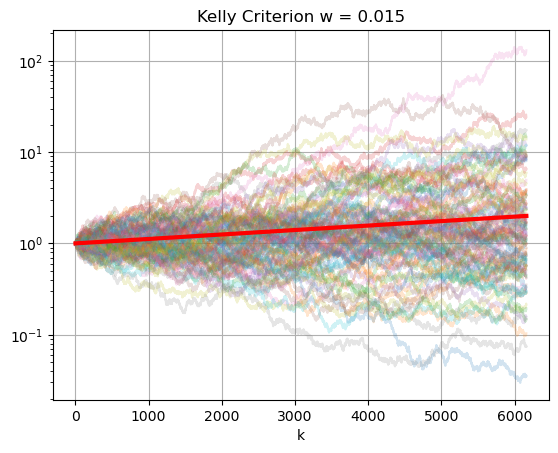
Example 2. Multiple Outcomes#
import numpy as np
import matplotlib.pyplot as plt
w1 = np.linspace(0.001, 0.999)
w2 = 0
w3 = 0
p1 = 1/2
p2 = 1/3
p3 = 1/6
R1 = 1 + 2*w1 - w2 - w3
R2 = 1 - w1 + w2 - w3
R3 = 1 - w1 - w2 + 5*w3
m = p1*np.log(R1) + p2*np.log(R2) + p3*np.log(R3)
plt.plot(w1,m)
plt.grid()

def wheel(w,N = 100):
w1, w2, w3 = w
Example 3. Stock/Bond Portfolio in Continuous Time#
%matplotlib inline
import matplotlib.pyplot as plt
import numpy as np
import pandas as pd
import datetime
from pandas_datareader import data, wb
from scipy.stats import norm
import requests
def get_symbol(symbol):
"""
get_symbol(symbol) uses Yahoo to look up a stock trading symbol and
return a description.
"""
url = "http://d.yimg.com/autoc.finance.yahoo.com/autoc?query={}®ion=1&lang=en".format(symbol)
result = requests.get(url).json()
for x in result['ResultSet']['Result']:
if x['symbol'] == symbol:
return x['name']
symbol = '^GSPC'
# end date is today
end = datetime.datetime.today().date()
# start date is three years prior
start = end-datetime.timedelta(1.5*365)
# get stock price data
S = data.DataReader(symbol,"yahoo",start,end)['Adj Close']
rlin = (S - S.shift(1))/S.shift(1)
rlog = np.log(S/S.shift(1))
rlin = rlin.dropna()
rlog = rlog.dropna()
# plot data
plt.figure(figsize=(10,6))
plt.subplot(3,1,1)
S.plot(title=get_symbol(symbol))
plt.ylabel('Adjusted Close')
plt.grid()
plt.subplot(3,1,2)
rlin.plot()
plt.title('Linear Returns (daily)')
plt.grid()
plt.tight_layout()
plt.subplot(3,1,3)
rlog.plot()
plt.title('Log Returns (daily)')
plt.grid()
plt.tight_layout()
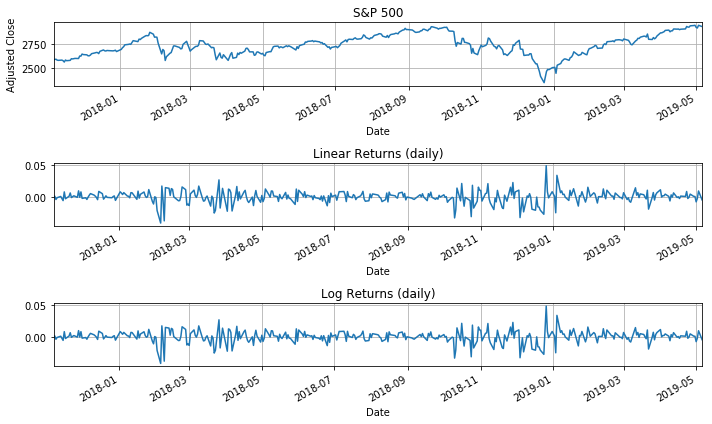
print('Linear Returns')
mu,sigma = norm.fit(rlin)
print(' mu = {0:12.8f} (annualized = {1:.2f}%)'.format(mu,100*252*mu))
print('sigma = {0:12.8f} (annualized = {1:.2f}%)'.format(sigma,100*np.sqrt(252)*sigma))
print()
print('Log Returns')
nu,sigma = norm.fit(rlog)
print(' nu = {0:12.8f} (annualized = {1:.2f}%)'.format(nu,100*252*nu))
print('sigma = {0:12.8f} (annualized = {1:.2f}%)'.format(sigma,100*np.sqrt(252)*sigma))
Linear Returns
mu = 0.00037731 (annualized = 9.51%)
sigma = 0.00961646 (annualized = 15.27%)
Log Returns
nu = 0.00033089 (annualized = 8.34%)
sigma = 0.00963609 (annualized = 15.30%)
mu = 252*mu
nu = 252*nu
sigma = np.sqrt(252)*sigma
rf = 0.04
mu = 0.08
sigma = 0.3
w = (mu-rf)/sigma**2
nu_opt = rf + (mu-rf)**2/2/sigma/sigma
sigma_opt = np.sqrt(mu-rf)/sigma
print(w,nu_opt,sigma_opt)
0.4444444444444445 0.04888888888888889 0.6666666666666667
Volatility Pumping#
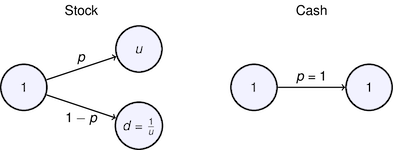
# payoffs for two states
u = 1.059
d = 1/u
p = 0.54
rf = 0.004
K = 100
ElnR = p*np.log(u) + (1-p)*np.log(d)
print("Expected return = {:0.5}".format(ElnR))
Z = np.array([float(random.random() <= p) for _ in range(0,K)])
R = d + (u-d)*Z
S = np.cumprod(np.concatenate(([1],R)))
ElnR = lambda alpha: p*np.log(alpha*u +(1-alpha)*np.exp(rf)) + \
(1-p)*np.log(alpha*d + (1-alpha)*np.exp(rf))
a = np.linspace(0,1)
plt.plot(a, list(map(ElnR, a)))
Expected return = 0.004586
[<matplotlib.lines.Line2D at 0x7fad84ce3d00>]
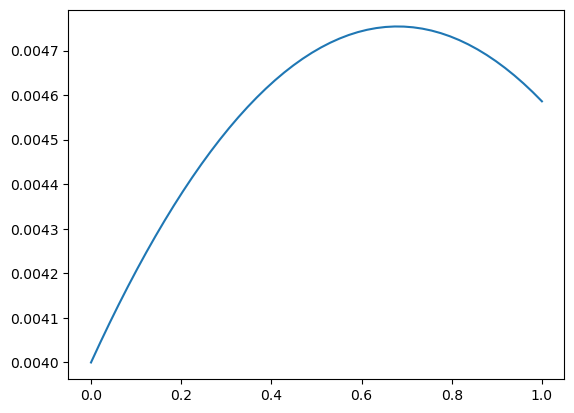
from scipy.optimize import fminbound
alpha = fminbound(lambda alpha: -ElnR(alpha), 0, 1)
print(alpha)
#plt.plot(alpha, ElnR(alpha),'r.',ms=10)
R = alpha*d + (1-alpha) + alpha*(u-d)*Z
S2 = np.cumprod(np.concatenate(([1],R)))
plt.figure(figsize=(10,4))
plt.plot(range(0,K+1),S,range(0,K+1),S2)
plt.legend(['Stock','Stock + Cash']);
0.6799130096484951
